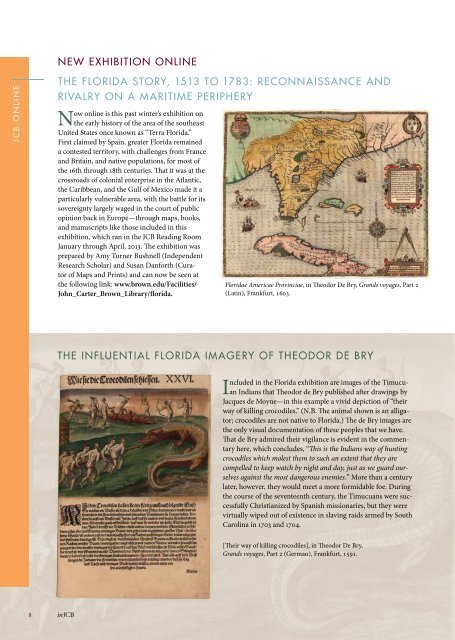You also want an ePaper? Increase the reach of your titles
YUMPU automatically turns print PDFs into web optimized ePapers that Google loves.
NEW EXHIBITION ONLINE<br />
<strong>JCB</strong> Online<br />
THE FLORIDA STORY, 1513 TO 1783: RECONNAISSANCE AND<br />
RIVALRY ON A MARITIME PERIPHERY<br />
Now online is this past winter’s exhibition on<br />
the early history of the area of the southeast<br />
United States once known as “Terra Florida.”<br />
First claimed by Spain, greater Florida remained<br />
a contested territory, with challenges from France<br />
and Britain, and native populations, for most of<br />
the 16th through 18th centuries. That it was at the<br />
crossroads of colonial enterprise in the Atlantic,<br />
the Caribbean, and the Gulf of Mexico made it a<br />
particularly vulnerable area, with the battle for its<br />
sovereignty largely waged in the court of public<br />
opinion back in Europe—through maps, books,<br />
and manuscripts like those included in this<br />
exhibition, which ran in the <strong>JCB</strong> Reading Room<br />
January through April, 2013. The exhibition was<br />
prepared by Amy Turner Bushnell (<strong>In</strong>dependent<br />
Research Scholar) and Susan Danforth (Curator<br />
of Maps and Prints) and can now be seen at<br />
the following link: www.brown.edu/Facilities/<br />
John_Carter_<strong>Brown</strong>_Library/florida.<br />
Floridae Americae Provinciae, in Theodor De Bry, Grands voyages, Part 2<br />
(Latin), Frankfurt, 1603.<br />
THE INFLUENTIAL FLORIDA IMAGERY OF THEODOR DE BRY<br />
<strong>In</strong>cluded in the Florida exhibition are images of the Timucuan<br />
<strong>In</strong>dians that Theodor de Bry published after drawings by<br />
Jacques de Moyne—in this example a vivid depiction of “their<br />
way of killing crocodiles.” (N.B. The animal shown is an alligator;<br />
crocodiles are not native to Florida.) The de Bry images are<br />
the only visual documentation of these peoples that we have.<br />
That de Bry admired their vigilance is evident in the commentary<br />
here, which concludes, “This is the <strong>In</strong>dians way of hunting<br />
crocodiles which molest them to such an extent that they are<br />
compelled to keep watch by night and day, just as we guard ourselves<br />
against the most dangerous enemies.” More than a century<br />
later, however, they would meet a more formidable foe. During<br />
the course of the seventeenth century, the Timucuans were successfully<br />
Christianized by Spanish missionaries, but they were<br />
virtually wiped out of existence in slaving raids armed by South<br />
Carolina in 1703 and 1704.<br />
[Their way of killing crocodiles], in Theodor De Bry,<br />
Grands voyages, Part 2 (German), Frankfurt, 1591.<br />
8 in<strong>JCB</strong>
















